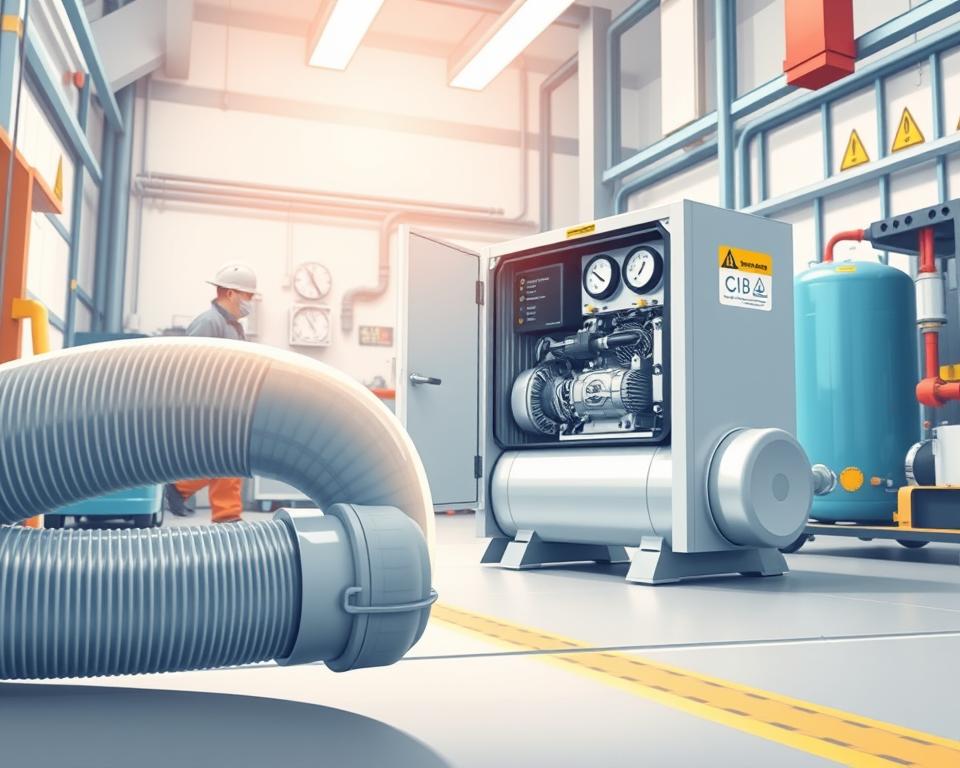Your Complete Guide to PVC Pipe in Compressed Air Systems
Did you know that a ruptured compressed air system can release energy equivalent to a stick of dynamite? Countless operations remain oblivious to the risks of certain piping systems they employ. Read on to discover why PVC air lines choices demand top-tier safety.
Although some plastics gain popularity, OSHA flatly forbids their above-ground application. Repeated contact with compressor oil and thermal cycling makes them brittle, causing explosive failures. Those so-called safe pressure limits don’t eliminate explosion risk.
Turn to Installation Parts Supply for sturdy aluminum systems. Spending on the right materials prevents OSHA penalties and protects employees. Here’s how to assemble a risk-free system.

Core Insights
- Explosion danger leads OSHA to outlaw some pipe materials.
- Temperature changes can halve pressure ratings.
- Long-term exposure makes pipes prone to brittle breaks.
- Aluminum lines deliver a far safer option.
- Invest wisely to dodge fines and protect staff.
Why You Shouldn’t Use PVC for Compressed Air
All major brands advise against certain plastics in compressed air. Compressed air carries destructive energy; a burst is like a dynamite blast. This makes material choice critical for safety.
- Brittleness: Sub-freezing temperatures turn materials brittle, increasing fracture risks.
- Adhesive failures: Oil contamination and heat cycles break down glue bonds.
- Misleading ratings: Most shops run above 110°F, slashing rated pressure in two.
OSHA cites a $110,000 fine after a facility’s piping shattered, injuring workers. Compression heating lowers allowable pressure even more—often ignored.
“Above-ground use of certain plastics for compressed air violates OSHA standards due to explosion risks.”
Metal alternatives fail more predictably, bending rather than fragmenting. Plastic shrapnel from explosive failures can travel over 50 feet, embedding in walls or equipment.
Workshops face daily temperature fluctuations that accelerate material degradation. Over 10 years, UV exposure and chemical interactions further compromise integrity, turning minor leaks into major hazards.
Best Materials Instead of PVC for Air Lines
Aluminum piping systems outperform traditional options in both safety and efficiency. With 90% fewer leaks than black pipe, they’re a top choice for modern facilities. Aluminum’s lightness and anti-rust traits prolong system life.
Threadless modular aluminum assemblies speed assembly. Installation Parts Supply stocks ready-to-snap aluminum modules. A car plant saw a 40% drop in labor expenses after aluminum installation.
- Copper: Ideal in sterile environments for its germ-killing copper surface. Requires soldering expertise.
- Stainless Steel: Stainless steel stands up to salty, moist conditions.
- ABS/HDPE: For solvent-rich environments, ABS/HDPE stays intact.
“Our aluminum retrofit reduced energy waste by 15%—paying for itself in 18 months.”
Proper torque is critical. Too tight splits fittings; too loose lets air escape. Aluminum fittings generally torque to 25–30 ft-lbs—follow the guide.
NSF-approved lines keep food-grade air clean. Choose pipe rated for your specific operating environment.
Material Selection Guide for Compressed Air
Selecting the best material for your setup requires balancing cost, safety, and efficiency. Switching to aluminum saved a factory $12k each year. Here’s how to make the right choice.
| Material | Cost (per ft) | Maintenance | ROI Time |
|---|---|---|---|
| Aluminum | $8.50 | Low | 18 months |
| Black Pipe | $5.00 | High | N/A |
| Copper | $10.20 | Medium | 24 months |
Temperature matters. From arctic chills to high heat, aluminum outperforms. Stainless steel stands up to harsh chemicals.
Pro Tip: Compute ROI based on compressed-air leakage. Don’t let 10% leakage cost you $3,500 a year.
- Match PSI ratings to your compressor’s output.
- Verify your system meets OSHA welding and pressure-test rules.
- Contact Installation Parts Supply for a no-cost audit.
“Our aluminum retrofit cut energy waste by 15%—paying for itself in 18 months.”
Hire pros for big installs to guarantee airtight connections. Check warranties—some pipes include decade-long coverage.
In Summary
Safety outweighs sticker price in compressed-air piping. Studies show 92% of failures happen in older systems, often with dangerous results. Aluminum offers 99.8% reliability, making it a smart long-term choice.
Don’t forget:
- Say no to plastics that can explode.
- Metallic lines beat plastics on both safety and durability.
- Ignoring standards invites fines and insurance headaches.
Upgrade now and secure your workplace. Grab same-day pricing and deals on kits from Installation Parts Supply. Request your free template or emergency service today.
Commit to safer piping today—your team’s safety depends on it.